Clifton Church Alterations and Additions
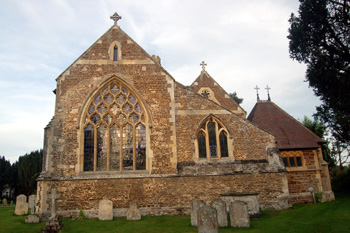
The east end August 2009
Former County Archivist Chris Pickford produced a number of volumes for Bedfordshire Historical Records Society on Bedfordshire churches in the 19th century. Clifton was in the first of these (A-G), being society volume 73 published in 1994. All Saints church was very heavily restored by Rev. Henry Hugh Miles, the rector from 1858 to 1891, the architect being Edward Haycock junior of Shrewsbury, the rector's brother-in-law.
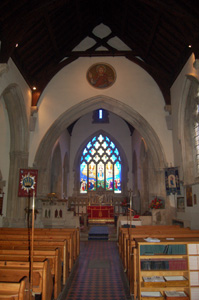
The nave looking east November 2009
An article on the church appeared in the Northamptonshire Mercury of 19th February 1853 (before Haycock's restoration) by John Martin, librarian of Wobun Abbey. His articles on Bedfordshire churches are marked by pompous invective. It described the church as follows: "The chancel roof is open and in good condition, The walls are whitewashed, disfiguring greatly the beautiful decorations of the sedilia".
"The intelligent person who admitted us, stated that the parishioners dreaded the expense of removing this unseemly eyesore. The spirit of those who dreamed not of expense, when temples of worship were erected ungrudgingly, hovers not over the men of Clifton. In addition to this melancholy plastering, an enormous pew, appropriated to the reverend incumbent [Daniel Olivier], lent its aid in thus spoiling the harmony and beauty of this part of the building".
"The nave has an open timber roof. Some of the original benches remain. The belfry arch is boarded up. It appeared to be a very fine one, but jammed with repeated coats of whitewash".
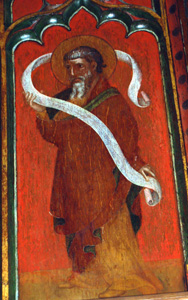
A prophet from the 15th century screen November 2009
"In the south aisle [i.e. the nave] a gallery has been erected, the front panelling of which, in brazen audacity, proclaims the spoliation of the tomb in the chantry chapel, erected to Sir Michael Fisher [now known to be Sir Thomas Lucy], and which was described by Lysons some years ago as having "its sides richly ornamented with tabernacle work" [this 15th century screen has now been restored and stands at the west end of the nave - the tabernacle work being pairs of Old Testament prophets and New Testament saints].
"Attempt to render a square pew more in harmony with the building, giving more space for the congregation, and the storm of indignation on the part of the worthy occupants is quite awful, but not a word is even whispered, when the carpenter's labour may be lessened by plundering the tombs of the departed".
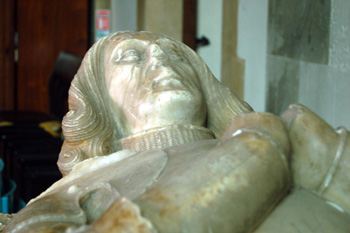
Sir Thomas Lucy November 2009
"What remains of the wooden decorations have hitherto escaped the daubing brush, thus permitting the figures, around whose heads the nimbus is displayed, to be seen. The marble monument, a recumbent figure, is in tolerable repair; but it is to be apprehended from the spoliation already mentioned, it will lapse into ruin, unless some descendant survives who has respect for the tomb of his ancestor".
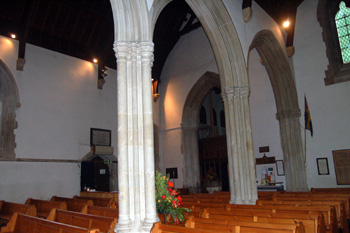
Looking south-west from the north from the north aisle into the nave November 2009
"The brass decorations of another have been abstracted and the slab serves as a resting place for faggots; opposite is a chopping block for the same. The ornaments of the capitals of the columns would, if cleansed from the impurities which clog them up, exhibit beautiful examples".

Clifton font showing the 15th century screen behind November 2009
"The font is of purbeck stone, placed on a modern pedestal, overlaid with plaster".
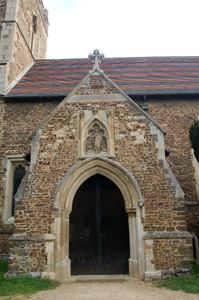
The porch August 2009
"The porch is sadly decayed; the lead remains on the chancel, a rare occurrence, it is also on the nave".
"The churchyard is kept locked up".

Looking north-west from the nave to the north aisle November 2009
The first restoration came in 1862-1863 with rebuilding of the north aisle, the addition of an organ chamber and vestry and renewal of the roof, which was raised.
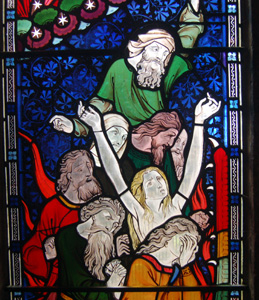
The damned shown in the west window November 2009
Three stained glass windows by Hardman were also added to the church. The magnificent west window was restored in 1992 as the details, for axample, the faces of the charecters, had faded.
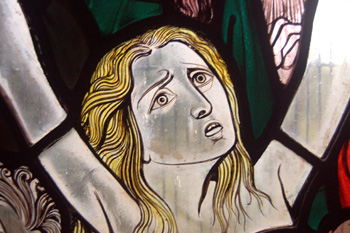
Detail from the group of damned on the west window November 2009
The rector donated a new clock in 1863 and added quarter chimes in 1867 and a carillon which played tunes on fifteen small bells in 1869.

Christ the Redeemer November 2009
In 1874 the chancel was embellished by a reredos and a mosaic of Christ the Redeemer over the chancel arch. The new vestry enlarged. A new organ was installed in 1886. In 1992 the 15th century rood screen and its paintings were restored.
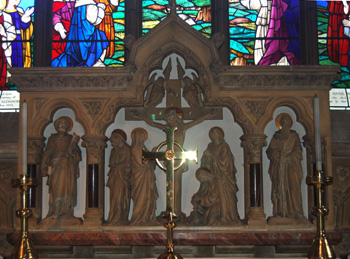 The reredos November 2009
The reredos November 2009